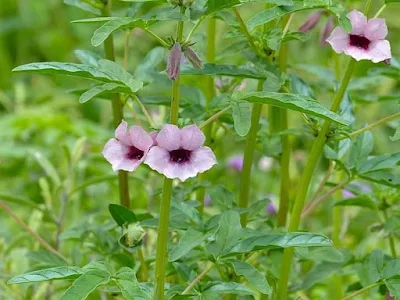Did you know that Sesame, one of India's oldest and most precious plant in Hinduism, is considered to be the oldest known crop to humanity in the form of oil seed (Ellu)?
Sesame
Did you know that Sesame, one of India's oldest and most precious plant in Hinduism, is considered to be the oldest known crop to humanity in the form of oil seed (Ellu)?
Sesame, with botanical name Sesamum indicuma, a flowering plant in the genus Sesamum, also called benne in English since 1769, is one of India's oldest and most precious crops considered a Divine gift given by God, growing for more than 5000 years and it now accounts for about a quarter of sesame production worldwide.
Sesame plant is a variable, erect, annual plant that can grow from 1 - 3 metres tall. Plants can be branched or unbranched. The root system has a strongly tapering taproot up to 90cm long. Its Leaf arrangement is Alternate-spiral. Its bell shaped flowers, white to pale-rose in colour, ffowering from April to September develop in the leaf axils 6 to 8 weeks after planting and this continues for several weeks. Its fruitrs in the form of deeply goved capsules, of 1 to 3 inch size, mature 4 to 6 weeks after fertilization. The plant has been cultivated for its edible seed and sesame oil since at least 5,000 BC, and is still widely grown in tropical and warm temperate zones trhoughout the world.
While Sesame is known as Gingelly in English, its vernacular names in India are: Ellu, Achhellu, Kari ellu in Kannada; Snehaphala, Tila, Tilaha, Tilataila in Sanskrit; Jungli Til in Hindi; Karuellu in Malayalam; Caralam, Caralam, Carali, Caralicceti, Cinekapalacceti in Tamil; and Gubbulu, Guvvulu,in Telugu. It is grown in several varieties depending on its market value but the two traditional varieties popularly grown are white-coated and black coated varieties. Most wild species of the genus Sesamum are native to sub-Saharan Africa. S. indicum, the cultivated type, originated in India.
Sesame seed, a product of the pods of Sesame, is considered to be the oldest oilseed crop known to humanity. The genus has many species, and most are wild. Sesame seeds are extracted by shaking the dried plant upside down after making an incision in the seed pod. Sesame oil is extracted from the seeds and is the most popular oil used in India, especially in the summer months. Sesame seeds have many potential health benefits and have been used in folk medicine for thousands of years.
Sesame oil is a thick liquid with a golden yellow colour and a slight nutty aroma. Sesame oil plays a prominent role in Indian Ayurvedic medicine. Sesame seeds are rich in vitamin E and minerals such as iron, calcium, and phosphorous which help nourish and protect the hair and skin. Sesame seed is a common ingredient in various cuisines. Sesame seeds are used whole in cooking for its rich, nutty flavour. However, Sesame can trigger some allergic reactions, including anaphylaxis, as seen with other food allergens.
The fact is, however , that sesame only became important in greater India within the context of Hinduism. The entire Tilak ceremony in Hinduism is developed around the tiny Til or Sesame, which symbolizes the pores of Vishnu. Garuda Purana says that Til originated from the pores of the Lord Vishnu and is sacred to Him. It is beleived that sesame has been one of the oldest plants to be cultivated, a Divine gift given by god. The sesame pod and oil are used in worship. In a Hindu marriage ceremony, the bride and groom offer barley, rice and sesame to the Fire God (Agni) that symbolises frutifullness and prospertiy. In Indian religiuos culture sesame seeds are strictly connected to conception and to procreation. Therefore, they are the symbol of rebirth. For this reason they were used in rituals for ancestors, to whom it could open the doors of heaven and to get favour from Yama. According to Brahma Purana, Sesame was created by Yama after a long penitence to be used in funerals as a purifier and symbol of immortality. In most Hindu societies particuarly during the festival of Makara Sankranthi (the day of transition of Sun into the zodiacal sign Capricorn or Makara in Sanskrit), when Sun god is worshipped along with Lord Vishnu and goddess Lakshmi throughout India, Til (Ellu) is shared with all, in diferent cuisine forms, as a token of harmony, good will and greetings.
Of all the health benefits of sesame seeds, the 5 most health benefits could be listed as: 1 To lower Cholesterol and Triglycerides; 2. For weight management options; 3. To Lower Blood Pressure; 4. To support healthy bones; and 5. To soothe Arthritic Knee Pain. However, one needs to eat significant amounts of Til — a small handful per day — to gain health benefits.,
Seasame oil is sometimes rubbed into the skin during abhyanga, a form of Ayurvedic therapy, an Indian massage that focuses on over 100 points on the body called marma points. Abhyanga is believed to improve energy flow and helps to free the body of impurities Sesame oil is easily removed from clothing than most other oils.
- Narasipur Char











Comments